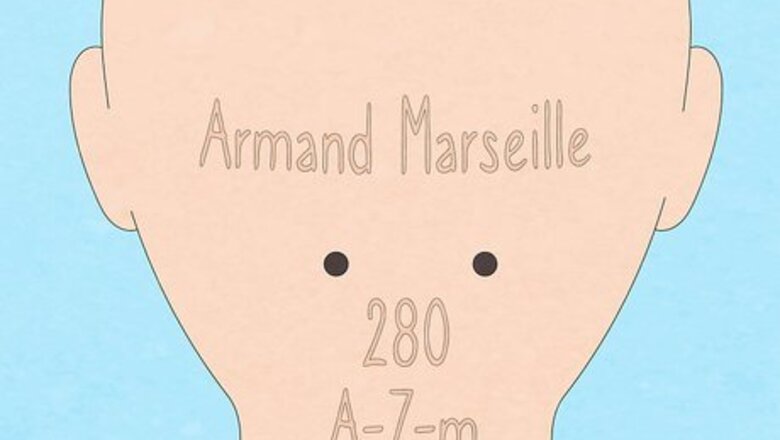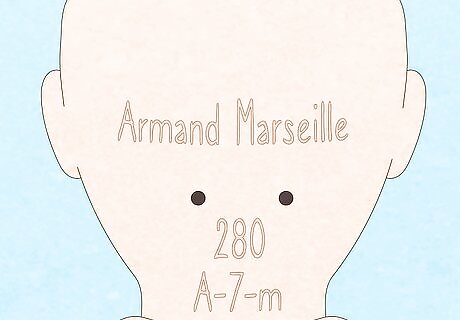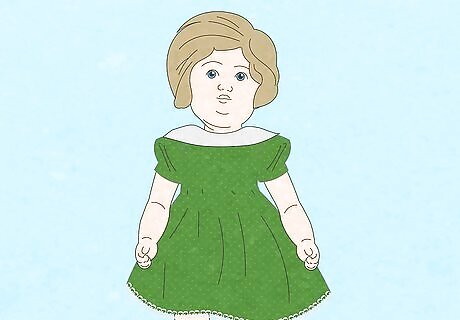
views
- Check for the maker’s mark on your doll’s neck, back of the head, lower or mid back, or foot. It could also be sewn into your doll’s clothing.
- Search the letters, numbers, and symbols on the mark to determine what kind of doll you have.
- If it’s unmarked, study the features of your doll and search them to try and find a match, or go to a doll appraiser.
Checking the Manufacturer's Mark

Check the back of the head for the manufacturer's mark. The manufacturer’s mark is often on the back of the head, under the doll’s hair if it has a wig. It could also be on the doll’s back, under its arms, on the soles of its feet, or sewn onto its body or clothing. Maker’s marks tell you the brand name and size of the doll, and those imported to America after 1890 have the country of origin as well, due to the McKinley tariff. Some dolls were sold with a wrist tag instead of a maker's mark, and handmade dolls don’t have maker’s marks. If you can’t find one, take the doll to an appraiser or check its materials.

Use the manufacturer's mark to browse reference books and websites. Look up the information from the mark online or go to a site like dollreference.com to find your doll. You can also find reference books at your local library. Other resources to check out are the National Antique Dolls Dealers Association (NADDA), the United Federation of Doll Clubs, inc., and Antique Doll Collector Magazine’s digital back issues. This is the most accurate way of identifying the doll, as it can be difficult to rely solely on the appearance. If you can’t find your exact doll, try to find similar ones on auction sites or Amazon. If you know you have an 8-inch Madame Alexander doll, for example, search those terms online.
Using Materials to Identify Dolls

Check the material of the head, hands, and feet. Antique dolls come in a few common styles. The oldest dolls are china and have glazed (shiny) hands, feet, and headpieces. Bisque dolls are made from unglazed (matte) porcelain, which gives them a more skin-like texture. To check if your doll is porcelain, hold the head of the doll to your teeth. If it feels hard and cold, it’s china or bisque. Bisque has small pores that collect dust and dirt. Usually the more dirt in the pores, the older the doll is. Parian dolls are untinted bisque and weren’t meant to be played with. You can identify them by their stark white color. Other doll-making materials include composition (sawdust, wood, and glue), cloth, metal, celluloid, leather, and wax.

Inspect the body of the doll for 2 holes near the shoulders. The head, neck, and shoulders of antique porcelain and bisque dolls are made using 1 mold. The 2 holes show where the head area was attached to the rest of the body. The holes can also be at the base of the neck.

Look at the stuffing of the doll if possible. Antique dolls that have bodies made out of leather or cloth are usually stuffed with sawdust or horsehair. They’re stuffed very tightly to support the weight of the head. Don’t damage the doll to check the stuffing, or that will lower the value. Antique dolls are never loosely stuffed, or stuffed with polyester. The oldest dolls are made out of porcelain or wood. The fully porcelain dolls were called “frozen” dolls, and are the most rare.

Look for cracked lines on the porcelain or bisque surface of the doll. Antique dolls develop fine lines that look like cracks, called crazes. They’re often across the face of the doll. The highest quality dolls often don’t have crazing, however. For example, a doll with very heavy craze lines on its face is probably very old.

Check if the eyes are painted, glass, or moveable. Antique dolls that were made before 1870 had eyes that were painted on. From 1870 to the early 1900s, the dolls had inset glass eyes that didn’t move. From the early 1900s, the eyes of the dolls are large and rounded, with a sideways glance. The painted eyes of dolls made before 1870 are usually light blue, however some are brown or black.

Check if the doll’s hair is rooted, a wig, or painted on. The majority of antique dolls have painted hair, which is black, brown, or blonde. The only exception is for German antique porcelain dolls, which often have wigs that are made out of mohair or human hair. The oldest china dolls usually had black hair that was parted down the middle. Red hair is very uncommon in antique porcelain dolls as it was believed to be unlucky. German porcelain dolls have wigs that are glued onto the head, as opposed to rooted wigs which is common in newer dolls. Mohair is the hair of an Angora goat.

Look for clothes that are old and faded. Clothes are an easy way to identify antique dolls, as the older the clothes appear, usually the older the doll itself too. The clothes are often dull, have signs of dust, and may be damaged. Antique dolls will never have modern velcro fastenings. Check the inside of the clothing for any tags that may give you more information about the doll.

Seek professional help if you can’t identify the doll. If finding or interpreting the manufacturer's label is difficult, contact a doll appraiser for help. These specialists are able to identify the type, era, and value of dolls accurately.
Identifying Common Manufacturers

Armand Marseille Armand Marseille’s company began making porcelain dolls in 1884 in Germany. The dolls are often Marked “AM” or with the doll’s name, and the mold number. The most common molds have a porcelain head with shoulders on a cloth or leather body, or a head with a socket (like a Barbie’s) on a jointed composition body. Most of their dolls have glass eyes.

Ideal Novelty & Toy Company These dolls were made from 1906 to 1939 and usually were modeled after characters or people, like Shirley Temple and Judy Garland. The antique dolls were made out of wood, cloth, and composition. Ideal Novelty & Toy Company dolls can be marked with “IDEAL” inside of a diamond, or they can say “I.N. & T. co.” They may also say “USA” or the name of the artist who designed them. Some dolls are unmarked. Antiques must be at least 100 years old, so not all Ideal Novelty & Toy Company dolls are antique yet.

Madame Alexander The Alexander Doll Company was famous for its stylish dolls. Since fashion was the primary focus, only a few doll molds were made, and the maker’s mark was sewn into the clothing. If your doll has its original clothing, check the seams for a tag. Madame Alexander dolls without their original clothing or wrist tags are incredibly difficult to identify.

Kewpie dolls by Rose O’Neill These cherubic baby dolls are made entirely of bisque, have star-shaped hands, pointy molded hair, and blue-tipped wings on their backs. They may say “O’Neill” or “Rose O’Neill” on the foot. Official antique Kewpie dolls were never made in Japan. If your doll says “Nippon” or “Japan” on it, it’s either a later doll or a knockoff.

Jumeau Bebe There are over a dozen Jumeau Bebe doll maker’s marks, sometimes with images or the word “Jumeau.” Jumeau dolls have large painted glass eyes, pouty lips, and wigs. They had kid (calf leather) and jointed bodies, and were often fashion dolls.
















Comments
0 comment